Marinha do Canadá
Moderador: Conselho de Moderação
- talharim
- Sênior

- Mensagens: 9831
- Registrado em: Sex Mai 07, 2004 11:40 pm
- Localização: Santos-SP
- Agradeceram: 212 vezes
Re: Marinha do Canadá
Olha depois dessa os Americanos tem razão em ficar zuando os Canadenses ate no American Dad mais que porra de pais acomodado e alienado para o Mundo em que vivem esses Canadenses vivem ........... são mais que os Brasileiros !!!!!!!!
"I would rather have a German division in front of me than a French
one behind me."
General George S. Patton.
one behind me."
General George S. Patton.
- henriquejr
- Sênior

- Mensagens: 5449
- Registrado em: Qui Mai 25, 2006 11:29 am
- Localização: Natal/RN
- Agradeceu: 384 vezes
- Agradeceram: 433 vezes
Re: Marinha do Canadá
Fazendo uma analogia bem grosseira, o Canadá está para os EUA, da mesma forma que a Nova Zelândia para a Austrália. Ambos são espécies de hospedeiros.
.
- P44
- Sênior

- Mensagens: 55548
- Registrado em: Ter Dez 07, 2004 6:34 am
- Localização: O raio que vos parta
- Agradeceu: 2832 vezes
- Agradeceram: 2495 vezes
Re: Marinha do Canadá
Canada unveils new procurement initiatives
David Carl, Toronto - IHS Jane's Defence Weekly
03 June 2016
Canada's Department of National Defence (DND) has released its 2016 Defence Acquisition Guide (DAG), outlining 38 new procurements required by the Canadian Armed Forces (CAF).
The DAG is part of the DND's replenishment cycle and involves upgrades and replacements for a variety of equipment, with potential contract values between less than CAD20 million (USD15 million) and over CAD1.5 billion.
This year's DAG, first released on 26 May, includes three contracts valued between CAD500 million and CAD1.5 billion. Two of those are related to the Royal Canadian Navy's (RCN) Halifax-class frigates. Divided between the east and west coasts, they are both for "coastal in-service support" contracts, providing maintenance and upgrades for the five West Coast and seven East Coast frigates.
http://www.janes.com/article/60964/cana ... nitiatives
David Carl, Toronto - IHS Jane's Defence Weekly
03 June 2016
Canada's Department of National Defence (DND) has released its 2016 Defence Acquisition Guide (DAG), outlining 38 new procurements required by the Canadian Armed Forces (CAF).
The DAG is part of the DND's replenishment cycle and involves upgrades and replacements for a variety of equipment, with potential contract values between less than CAD20 million (USD15 million) and over CAD1.5 billion.
This year's DAG, first released on 26 May, includes three contracts valued between CAD500 million and CAD1.5 billion. Two of those are related to the Royal Canadian Navy's (RCN) Halifax-class frigates. Divided between the east and west coasts, they are both for "coastal in-service support" contracts, providing maintenance and upgrades for the five West Coast and seven East Coast frigates.
http://www.janes.com/article/60964/cana ... nitiatives
*Turn on the news and eat their lies*
- akivrx78
- Sênior

- Mensagens: 6693
- Registrado em: Dom Fev 08, 2009 8:16 am
- Agradeceu: 118 vezes
- Agradeceram: 362 vezes
Re: Marinha do Canadá
Canadian navy to decommission its last research vessel, leaked documents reveal
David Pugliese, Ottawa Citizen | September 2, 2016 6:23 PM ET
More from David Pugliese, Ottawa Citizen

shipfax.comThe Canadian Forces Auxiliary Vessel Quest, an oceanographic research ship used by the navy and Defence Research and Development Canada, will be decommissioned.
The Canadian navy’s last research vessel will be decommissioned, leaving the country’s defence scientists without their own ship to conduct research in the Arctic and other locations, according to documents leaked to Postmedia.
The Canadian Forces Auxiliary Vessel Quest, an oceanographic research ship used by the navy and Defence Research and Development Canada, was sidelined in 2014 as a result of cost-cutting by the Conservative government.
Friday afternoon, an internal Department of National Defence (DND) email announced that the ship was being decommissioned.
In the email, Capt. Chris Sutherland, commander of the Canadian Forces Base Halifax, confirmed he had received a letter from Vice Adm. Mark Norman, vice-chief of the Defence Staff, about the fate of the ship.
They’ve refused to tell us anything and then on a Friday afternoon, just before a long weekend, they spring this on their employees
“I am now able to share with you the decision from the VCDS that CFAV Quest will be divested,” Sutherland wrote.
A disposal plan for the ship will be developed, but the commander’s message did not contain details on the timing of that process.
The ship has a 55-member civilian crew, which includes defence scientists.
John MacLennan, national president for the Union of National Defence Employees, said his organization has been trying for two years to get an answer from the Canadian military and the DND about the future of the ship.
“They’ve refused to tell us anything and then on a Friday afternoon, just before a long weekend, they spring this on their employees,” said MacLennan.
“It’s par for the course on the way that DND treats its workers.”
FileIn an email, Capt. Chris Sutherland, commander of the Canadian Forces Base Halifax, confirmed he had received a letter from Vice Adm. Mark Norman, pictured, vice-chief of the Defence Staff, about the fate of CFAV Quest.
The Quest has carried out valuable research in the Arctic and in testing sonar and other specialized equipment, as well as contributing to NATO testing, said MacLennan, whose union represents some of the crew.
The ship was commissioned in 1969, but underwent an upgrade in 1999.
In a 2012 article in the Canadian Naval Review, Mark Tunnicliffe, a retired navy officer, noted the vessel has a mandate of not only contributing to acoustic systems development but an “entire range of technologies and concepts needed to support the requirement specifications for the next generation of Canadian warships.”
During a 2012 Arctic mission, for instance, the vessel supported testing for unmanned air, surface and subsurface vehicles and an experimental Arctic surveillance system, Tunnicliffe wrote.
In his email, Sutherland said that he wants to meet next week with union representatives as well as hold a town-hall meeting with the crew of CFAV Quest.
http://news.nationalpost.com/news/canad ... nts-reveal
David Pugliese, Ottawa Citizen | September 2, 2016 6:23 PM ET
More from David Pugliese, Ottawa Citizen

shipfax.comThe Canadian Forces Auxiliary Vessel Quest, an oceanographic research ship used by the navy and Defence Research and Development Canada, will be decommissioned.
The Canadian navy’s last research vessel will be decommissioned, leaving the country’s defence scientists without their own ship to conduct research in the Arctic and other locations, according to documents leaked to Postmedia.
The Canadian Forces Auxiliary Vessel Quest, an oceanographic research ship used by the navy and Defence Research and Development Canada, was sidelined in 2014 as a result of cost-cutting by the Conservative government.
Friday afternoon, an internal Department of National Defence (DND) email announced that the ship was being decommissioned.
In the email, Capt. Chris Sutherland, commander of the Canadian Forces Base Halifax, confirmed he had received a letter from Vice Adm. Mark Norman, vice-chief of the Defence Staff, about the fate of the ship.
They’ve refused to tell us anything and then on a Friday afternoon, just before a long weekend, they spring this on their employees
“I am now able to share with you the decision from the VCDS that CFAV Quest will be divested,” Sutherland wrote.
A disposal plan for the ship will be developed, but the commander’s message did not contain details on the timing of that process.
The ship has a 55-member civilian crew, which includes defence scientists.
John MacLennan, national president for the Union of National Defence Employees, said his organization has been trying for two years to get an answer from the Canadian military and the DND about the future of the ship.
“They’ve refused to tell us anything and then on a Friday afternoon, just before a long weekend, they spring this on their employees,” said MacLennan.
“It’s par for the course on the way that DND treats its workers.”
FileIn an email, Capt. Chris Sutherland, commander of the Canadian Forces Base Halifax, confirmed he had received a letter from Vice Adm. Mark Norman, pictured, vice-chief of the Defence Staff, about the fate of CFAV Quest.
The Quest has carried out valuable research in the Arctic and in testing sonar and other specialized equipment, as well as contributing to NATO testing, said MacLennan, whose union represents some of the crew.
The ship was commissioned in 1969, but underwent an upgrade in 1999.
In a 2012 article in the Canadian Naval Review, Mark Tunnicliffe, a retired navy officer, noted the vessel has a mandate of not only contributing to acoustic systems development but an “entire range of technologies and concepts needed to support the requirement specifications for the next generation of Canadian warships.”
During a 2012 Arctic mission, for instance, the vessel supported testing for unmanned air, surface and subsurface vehicles and an experimental Arctic surveillance system, Tunnicliffe wrote.
In his email, Sutherland said that he wants to meet next week with union representatives as well as hold a town-hall meeting with the crew of CFAV Quest.
http://news.nationalpost.com/news/canad ... nts-reveal
- akivrx78
- Sênior

- Mensagens: 6693
- Registrado em: Dom Fev 08, 2009 8:16 am
- Agradeceu: 118 vezes
- Agradeceram: 362 vezes
Re: Marinha do Canadá
Canadian navy will lose submarine fleet in next few years without billions in upgrades: DND report
Lee Berthiaume, The Canadian Press | September 7, 2016 7:16 PM ET

HMCS Windsor, one of Canada's four Victoria-class submarines, in Halifax harbour on May 26, 2016.
THE CANADIAN PRESS/Andrew VaughanHMCS Windsor, one of Canada's four Victoria-class submarines, in Halifax harbour on May 26, 2016.
OTTAWA — The navy’s submarine fleet will have to be cut adrift in the next few years unless the federal government opts to spend billions to upgrade the ships, according to internal Defence Department documents.
The documents show that the first submarine, HMCS Victoria, is scheduled to reach its end of service life in 2022. The other three vessels will follow until the last, HMCS Windsor, retires in 2027.
The documents, released to The Canadian Press through the Access to Information Act, peg the cost of extending the lives of the submarines at between $1.5 billion and $3 billion, depending on how long the vessels would remain in service and what technical upgrades would be made. They don’t specify when a decision needs to be made, but work needs to begin by 2020 to prevent a gap.
Military officials have recently praised the submarines. Royal Canadian Navy commander Vice-Admiral Ron Lloyd described the vessels in June as “essential” to the navy’s ability to protect the country and help NATO, an assessment that was echoed by defence chief Gen. Jonathan Vance.
“As Canadians, I think we want to know who’s operating on, above and below our water from a sovereignty perspective,” Lloyd said. “The one strategic asset that allows you to understand what’s operating below the water is a submarine. Nothing else can replace that.”
But any investment is likely to stoke controversy. The submarines have been plagued by technical problems since they were bought used from the United Kingdom in 1998 for what the Chretien government described as a bargain $750 million.
While naval officials say they have managed to fix many of the problems and have started using the submarines in earnest, two were docked early this year over concerns about shoddy welding that prevented them from diving. Another had to be repaired after breaking down en route to a training exercise in Norway in June.
At the same time, the government is preparing to shell out billions for new fighter jets while the army has been clamouring for cash for new light and heavy trucks. Half of its current truck fleet has been parked because of age and maintenance costs.
The navy is also waiting to see how much money it will get from the government for new surface warships, which are slated for construction at the same time the submarine life extension would take place. The budget was previously set at $26 billion for up to 15 vessels, but recent estimates have put the cost much higher.
As Canadians, I think we want to know who’s operating on, above and below our water from a sovereignty perspective
Retired commodore Eric Lerhe, a senior fellow at Dalhousie University, says the navy has been trying to start a conversation about buying new submarines for some time. However, any purchase would take at least a decade, which is why a life extension to the existing fleet is considered necessary.
The document says that depending on the amount of work done, an extension could extend the lives of the submarines by between six and 18 years.
The Liberal government is currently developing a new defence policy, which will spell out what jobs the military will be expected to perform. That will have direct bearing on the types of equipment purchased in the coming years.
Lerhe acknowledged the current submarine fleet has had its teething problems. But he said actions by Russia and China plus the growing importance of the Arctic and the fact Canada has one of the longest coastlines in the world makes them essential. And he argued the estimated cost of the upgrades isn’t astronomical.
“What’s it going to cost to send peacekeepers to Mali?” he said. “In Afghanistan, the cost was $2 billion per year.”
http://news.nationalpost.com/news/canad ... dnd-report
Lee Berthiaume, The Canadian Press | September 7, 2016 7:16 PM ET

HMCS Windsor, one of Canada's four Victoria-class submarines, in Halifax harbour on May 26, 2016.
THE CANADIAN PRESS/Andrew VaughanHMCS Windsor, one of Canada's four Victoria-class submarines, in Halifax harbour on May 26, 2016.
OTTAWA — The navy’s submarine fleet will have to be cut adrift in the next few years unless the federal government opts to spend billions to upgrade the ships, according to internal Defence Department documents.
The documents show that the first submarine, HMCS Victoria, is scheduled to reach its end of service life in 2022. The other three vessels will follow until the last, HMCS Windsor, retires in 2027.
The documents, released to The Canadian Press through the Access to Information Act, peg the cost of extending the lives of the submarines at between $1.5 billion and $3 billion, depending on how long the vessels would remain in service and what technical upgrades would be made. They don’t specify when a decision needs to be made, but work needs to begin by 2020 to prevent a gap.
Military officials have recently praised the submarines. Royal Canadian Navy commander Vice-Admiral Ron Lloyd described the vessels in June as “essential” to the navy’s ability to protect the country and help NATO, an assessment that was echoed by defence chief Gen. Jonathan Vance.
“As Canadians, I think we want to know who’s operating on, above and below our water from a sovereignty perspective,” Lloyd said. “The one strategic asset that allows you to understand what’s operating below the water is a submarine. Nothing else can replace that.”
But any investment is likely to stoke controversy. The submarines have been plagued by technical problems since they were bought used from the United Kingdom in 1998 for what the Chretien government described as a bargain $750 million.
While naval officials say they have managed to fix many of the problems and have started using the submarines in earnest, two were docked early this year over concerns about shoddy welding that prevented them from diving. Another had to be repaired after breaking down en route to a training exercise in Norway in June.
At the same time, the government is preparing to shell out billions for new fighter jets while the army has been clamouring for cash for new light and heavy trucks. Half of its current truck fleet has been parked because of age and maintenance costs.
The navy is also waiting to see how much money it will get from the government for new surface warships, which are slated for construction at the same time the submarine life extension would take place. The budget was previously set at $26 billion for up to 15 vessels, but recent estimates have put the cost much higher.
As Canadians, I think we want to know who’s operating on, above and below our water from a sovereignty perspective
Retired commodore Eric Lerhe, a senior fellow at Dalhousie University, says the navy has been trying to start a conversation about buying new submarines for some time. However, any purchase would take at least a decade, which is why a life extension to the existing fleet is considered necessary.
The document says that depending on the amount of work done, an extension could extend the lives of the submarines by between six and 18 years.
The Liberal government is currently developing a new defence policy, which will spell out what jobs the military will be expected to perform. That will have direct bearing on the types of equipment purchased in the coming years.
Lerhe acknowledged the current submarine fleet has had its teething problems. But he said actions by Russia and China plus the growing importance of the Arctic and the fact Canada has one of the longest coastlines in the world makes them essential. And he argued the estimated cost of the upgrades isn’t astronomical.
“What’s it going to cost to send peacekeepers to Mali?” he said. “In Afghanistan, the cost was $2 billion per year.”
http://news.nationalpost.com/news/canad ... dnd-report
- P44
- Sênior

- Mensagens: 55548
- Registrado em: Ter Dez 07, 2004 6:34 am
- Localização: O raio que vos parta
- Agradeceu: 2832 vezes
- Agradeceram: 2495 vezes
Re: Marinha do Canadá
Canada's ever dwindling navy will lose Preserver October 21 and Athabaskan next spring.


https://twitter.com/seawaves_mag


https://twitter.com/seawaves_mag
*Turn on the news and eat their lies*
- P44
- Sênior

- Mensagens: 55548
- Registrado em: Ter Dez 07, 2004 6:34 am
- Localização: O raio que vos parta
- Agradeceu: 2832 vezes
- Agradeceram: 2495 vezes
Re: Marinha do Canadá
http://www.cbc.ca/news/politics/frigate ... -1.3812705
Canadá avança para o programa de NOVAS FRAGATAS
Canadá avança para o programa de NOVAS FRAGATAS
*Turn on the news and eat their lies*
- P44
- Sênior

- Mensagens: 55548
- Registrado em: Ter Dez 07, 2004 6:34 am
- Localização: O raio que vos parta
- Agradeceu: 2832 vezes
- Agradeceram: 2495 vezes
Re: Marinha do Canadá
Canada's last Iroquois-class destroyer to be paid off on March 10


*Turn on the news and eat their lies*
- P44
- Sênior

- Mensagens: 55548
- Registrado em: Ter Dez 07, 2004 6:34 am
- Localização: O raio que vos parta
- Agradeceu: 2832 vezes
- Agradeceram: 2495 vezes
- P44
- Sênior

- Mensagens: 55548
- Registrado em: Ter Dez 07, 2004 6:34 am
- Localização: O raio que vos parta
- Agradeceu: 2832 vezes
- Agradeceram: 2495 vezes
Re: Marinha do Canadá
Canada’s Navy urges sailors to attend Gay Pride parades in uniform
https://www.lifesitenews.com/news/canad ... in-uniform
https://www.lifesitenews.com/news/canad ... in-uniform
*Turn on the news and eat their lies*
- P44
- Sênior

- Mensagens: 55548
- Registrado em: Ter Dez 07, 2004 6:34 am
- Localização: O raio que vos parta
- Agradeceu: 2832 vezes
- Agradeceram: 2495 vezes
Re: Marinha do Canadá
Navantia team submits its proposal for CSC Frigate programme
Navantia team has announced the submission of its proposal for the Canadian Surface Combatant (CSC) program.
“We are pleased to announce that Navantia-led team has submitted its tender response for the Canadian Surface Combatant program, with Saab Australia as the Combat Systems Integrator (CSI) and CEA Technologies providing key elements of the proposed solution. With a strong heritage in designing and building frigates and destroyers and proven technology transfer in global programs, the Navantia team offers a compliant solution with the best capability for the Royal Canadian Navy and the Canadian shipbuilding industry”, said Navantia Chairman Esteban García Vilasánchez.
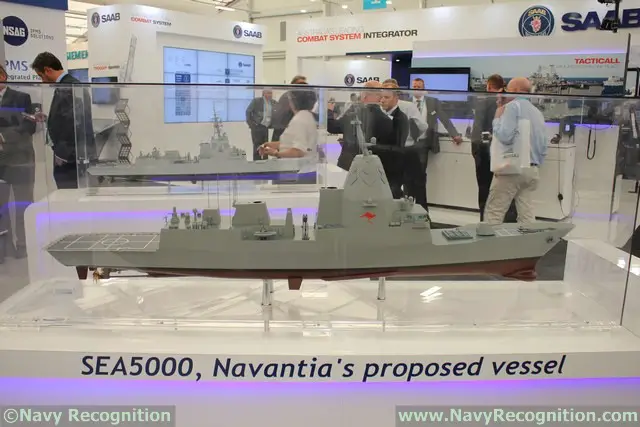
Navantia's SEA5000 proposal is based on the Hobart class Air Warfare Destroyer design. The CSC proposal is likely to be very similar, with the CEA radar.
The team’s proposal is focused on delivering an operationally proven design and leveraging the capabilities key Canadian companies to deliver a ship that is ideally suited to Canada’s requirement. A solution based on the proven F-105 frigate design for the Spanish Navy has been proposed.Navantia has a proud history of delivering for partner navies around the worldvariants of this design that are currently in service for Norwegian Navy and, most recently, the destroyer HMAS Hobart to the Royal Australian Navy (RAN).
This modern Anti-Submarine Warfare ship will incorporate Saab's globally recognised 9LV Combat Management Systems (CMS), elements of which are in service on over 240 platforms in 16 navies across the globe, including Canada’s own Halifax class frigates.Demonstrating the proven capabilities Saab Australia and the 9LVCMS it was recently mandated by the Australian Government for use on all major surface combatants of the Royal Australian Navy.
“Our expertise in developing high quality solutions for Australian programs in partnership with CEA Technologies, Navantia and others allows us to provide a low-risk, high capability solution for Canada, which will be fully interoperable with partner navies. The confidence of the Australian Government in mandating Saab combat systems and tactical interfaces across the whole RAN fleet demonstrates the strength of our capability and we look forward to continuing to work with the Royal Australian and Royal Canadian Navies to continue to develop our world-leading systems.”
The submission of the CSC bid is also a significant moment for CEA Technologies, providing further opportunities for global partnership, and recognition of the radar expertise the company has built.“

Scale model of Navantia Frigate design for SEA5000 at Pacific 2017
“We are excited about the opportunity to collaborate with Canada in the CSC program,” said CEA Technologies CEO Merv Davis.
“We can deliver a mature radar which is outperforming the expectations of the Royal Australian Navy and has substantial potential for future growth. Building partnerships through international programs such as CSC is an opportunity for CEA to continue to demonstrate the performance of our innovative solutions. We are proud to be able to provide our Australian technologies to our international partners and allies.”
Other key suppliers engaged by Saab to support the CSC program include Lockheed Martin (Moorestown, New Jersey), General Dynamic Mission Systems – Canada (GDMS-C), DRS Technologies Limited Canada (DRSTCL), OSI Maritime Service and Rheinmetall Canada.
"Our solution will utilise and develop the unique capabilities of over fifty Canadian companies and will create over one thousand long-term, high tech jobs in Canada. Our proposal includes a full technology transfer of Navantia's design and Saab's 9LV CMSto Canada to be integrated and maintained by Canadian companies.”
The F-105 is far beyond the conceptual stage of a slowly evolving design process, and is marketed based on proven operational performance as opposed to claims of wishful thinking. Selection of the Navantia solution will ensure Canada is not burdened with unnecessary cost and risk concerns as CSC transitions from design, to production and ultimately, to a proven operational capability.
"An exciting opportunity, the Navantia team looks forward to having the opportunity to work with Canada in developing and delivering the full capability of the Canadian Surface Combatant to the Royal Canadian Navy.”
Under the CSC program, the Royal Canadian Navy will acquire up to 15 frigates to replace the Iroquois Class destroyers and Halifax Class frigates. Construction of the frigates will begin in the early 2020s.
https://www.navyrecognition.com/index.p ... ramme.html
*Turn on the news and eat their lies*
- P44
- Sênior

- Mensagens: 55548
- Registrado em: Ter Dez 07, 2004 6:34 am
- Localização: O raio que vos parta
- Agradeceu: 2832 vezes
- Agradeceram: 2495 vezes
- P44
- Sênior

- Mensagens: 55548
- Registrado em: Ter Dez 07, 2004 6:34 am
- Localização: O raio que vos parta
- Agradeceu: 2832 vezes
- Agradeceram: 2495 vezes
- Penguin
- Sênior

- Mensagens: 18983
- Registrado em: Seg Mai 19, 2003 10:07 pm
- Agradeceu: 5 vezes
- Agradeceram: 374 vezes
Re: Marinha do Canadá
Sempre e inevitavelmente, cada um de nós subestima o número de indivíduos estúpidos que circulam pelo mundo.
Carlo M. Cipolla
Carlo M. Cipolla
- cabeça de martelo
- Sênior

- Mensagens: 40254
- Registrado em: Sex Out 21, 2005 10:45 am
- Localização: Portugal
- Agradeceu: 1187 vezes
- Agradeceram: 2973 vezes
Re: Marinha do Canadá

Note the 32 MK41 VLS cells fitted forward. Some (if not all) of them are in their "strike length" version in order to accommodate the Tomahawk LACM.
Royal Canadian Navy Unveils New Details On CSC Frigates
The Royal Canadian Navy (RCN) released the latest details on the configuration of its next generation frigates: the Canadian Surface Combatant (CSC). They will be heavily armed, featuring Naval Strike Missiles, Tomahawk and both ESSM and Sea Ceptor!
Xavier Vavasseur 09 Nov 2020
The RCN last week unveiled a PDF document shedding light on the latest configuration retained for its next gen class of frigate: the CSC. Naval News contacted various sources familiar with the program to confirm the selection of a number of systems listed in the document.
What stands out in this new document is fact that the CSC will be fitted with a wide range of weapons, both offensive and defense, in a mix never seen before in any surface combatant.
Naval Strike Missile (NSM)
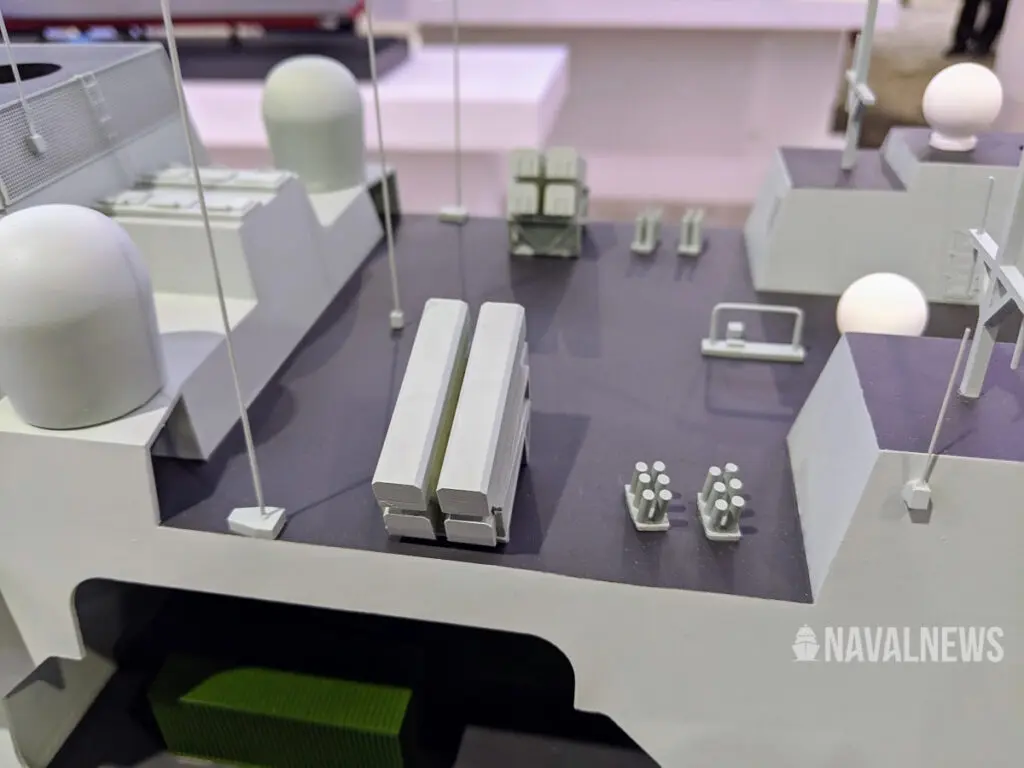
Close up view of the 8 NSM launchers on the CSC scale model on display on the Lockheed Martin booth at Sea Air Space 2019.
While NSM launchers were shown in the past on CSC scale models at various tradeshows (Surface Navy and Sea Air Space), the CSC model on display at DSEI 2019 was showing Harpoon launchers aboard the frigate.
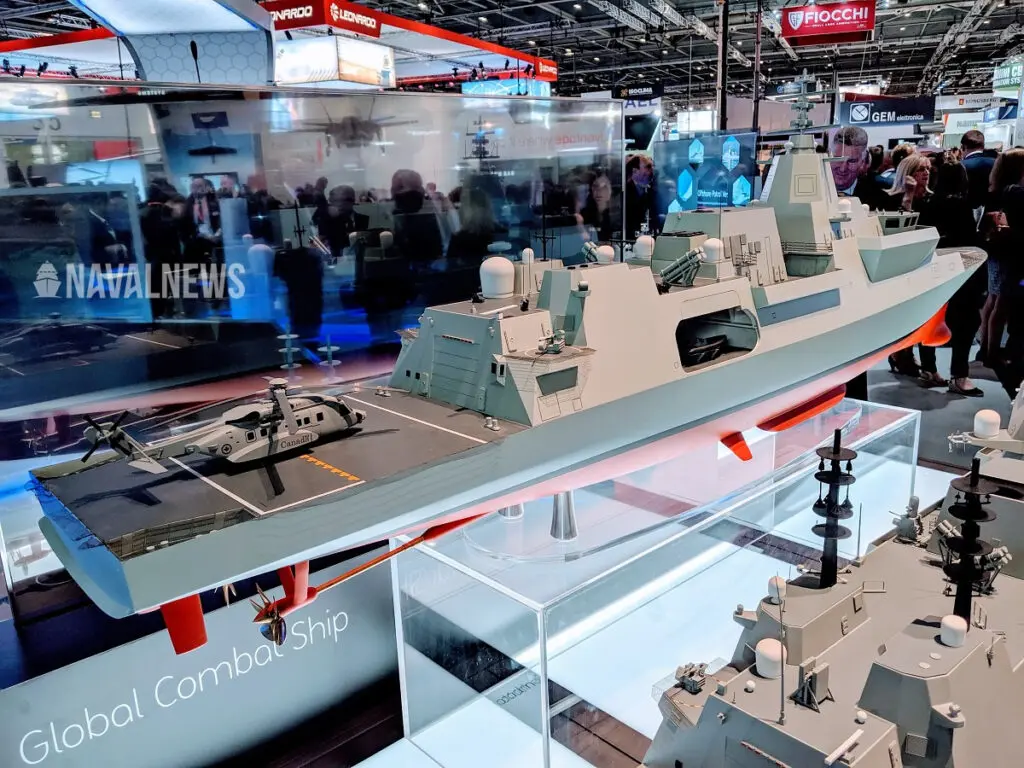
The CSC scale model at DSEI 2019 featured Harpoon launchers.
To our knowledge, it is the first time that an official Royal Canadian Navy lists the NSM as the main anti-surface warfare (ASuW) weapon for the CSC. Contacted by Naval News, an industry source said Kongsberg was close to finalizing the deal.
NSM has an operational range of 100 nautical miles (185 Km) and a high subsonic speed. It uses Inertial, GPS and terrain-reference navigation and imaging infrared homing (with a target database aboard the missile). The NSM is a fifth generation anti-sip missile, produced by Kongsberg and managed in the U.S. by Raytheon. NSM reached Initial Operational Capability on the Norwegian Fridtjof Nansen-class frigates and Skjold-class corvettes in 2012. It is also fielded by the Polish Navy (coastal defense batteries) and has been selected by the navies of Malaysia and Germany. NSM was also selected in 2018 as the winner of the U.S. Navy Over-The-Horizon Weapon System (OTH WS) competition and by the USMC last year. It will be fitted aboard the Littoral Combat Ship and the Constellation-class frigates. In the case of Canada, is selected, the NSM will likely be sourced from Raytheon via an FMS deal, rather than procured directly from Norway.
Tomahawk land attack cruise missile
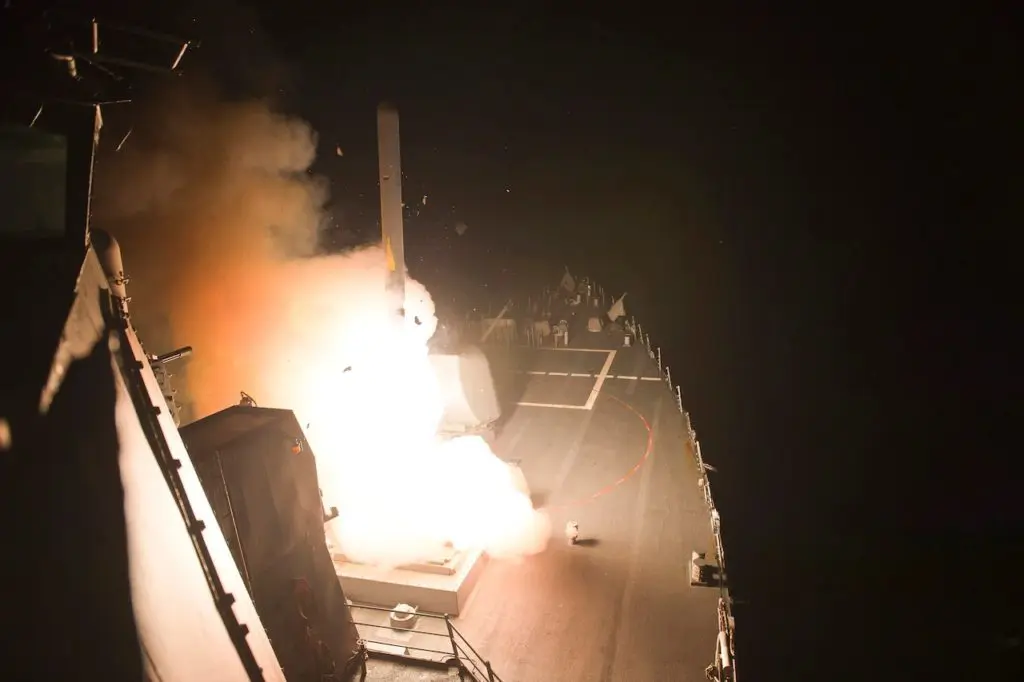
The guided-missile destroyer USS Arleigh Burke launches Tomahawk cruise missiles to conduct strikes against ISIS targets, Sept. 23, 2014. Photo By: Navy Petty Officer 2nd Class Carlos M. Vazquez II.
If Tomahawk missiles end up in the CSC weapons package, this would be quite significant. So far, Raytheon’s land attack cruise missile has only been exported to the United Kingdom in its submarine launched variant. Canada would become the second export customer for the missile and the only navy, with the US Navy to deploy it from surface vessels.
Naval News contacted Raytheon for comment but we have not heard back yet. During the Sea Air Space 2019 tradeshow, representatives from Lockheed Martin Canada confirmed to Naval News the MK41 VLS aboard the frigate were “strike length”.
The Tomahawk Land Attack Missile (TLAM) is a long-range, all-weather, jet-powered, subsonic cruise missile that is primarily used by the United States Navy and Royal Navy in ship- and submarine-based land-attack operations. Its latest variant, the RGM/UGM-109E Tomahawk Land Attack Missile (TLAM Block IV) has a range of 900 nautical miles (or 1,000 mi / 1,700 km).
ESSM and Sea Ceptor
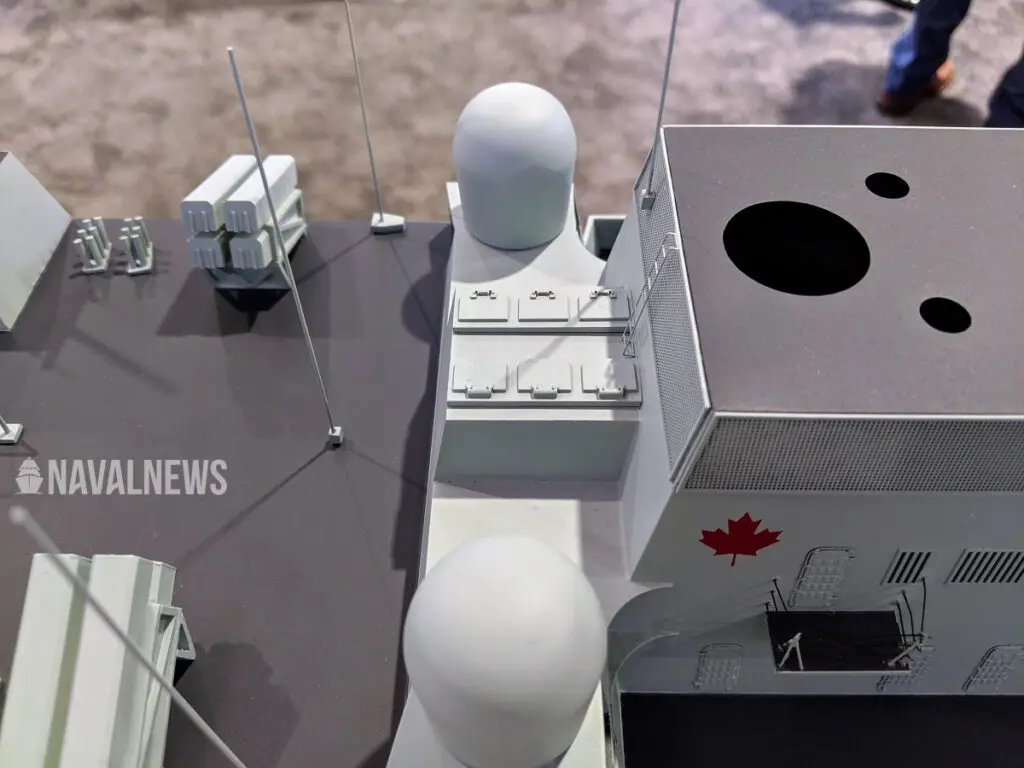
These are likely the ExlS cells for MBDA’s Sea Ceptor. The configuration would be 6 cells each carrying four missiles.
The last thing that really caught our attention in the RCN document is the fact that both the ESSM and Sea Ceptor are listed. On paper, the two missiles are direct competitors and redundant:
ESSM is a medium-range, all-weather, semi-active radar-guided missile used in surface-to-air and surface-to-surface roles. According to open sources, the RIM-162 Evolved SeaSparrow Missile (ESSM) has a range of about 27 nautical miles (50 Km) and a top speed of Mach 4+. Unlike ESSM Block 1, the Block 2’s active radar homing seeker will support terminal engagement without the launch ship’s target illumination radars. The improved ESSM Block 2 will be fielded by the US Navy from 2020. Canada is one of the 12 nations taking part in the NATO-led ESSM consortium and will be deploying the Block 2 variant aboard the future CSC. The will be launched from the Mk41 VLS. The missiles can be “quad packed” in a single cell.
According to MBDA, Sea Ceptor is the next-generation, ship-based, all-weather, air defence weapon system. The Weapon System has the capability to intercept and thereby neutralise the full range of current and future threats including combat aircraft and the new generation of supersonic anti-ship missiles. Capable of multiple channels of fire, the system will also counter saturation attacks. It has a range of 25 Km, a speed of Mach 3 and features an active RF seeker. Also known as Common Anti-Air Modular Missile (Maritime) – CAMM(M), this new missiles has already been fielded aboard the Royal Navy’s Type 23 frigates and the Royal New Zealand Navy ANZAC-class frigates. Sea Ceptor will also be fitted aboard the future Type 26 frigates.
Contacted by Naval News, an MBDA source shed some light on how the Sea Ceptor was selected in addition to the ESSM. The two missiles were not competing against each other. Raytheon’s ESSM was selected to provide “point defense”. Instead, MBDA pitched its missile for the RCN’s close in weapons system (CIWS) requirement. The Sea Ceptor beat out systems usually used in that role such as the RAM, SeaRam or Phalanx. The final Sea Ceptor configuration aboard the CSC still needs finalized and confirmed but it will likely be 24x missiles launched from Lockheed Martin’s Extensible Launching System (ExLS) located amidship. The RCN would become the launch customer for that new launcher alongside the Brazilian Navy (for its new corvette design based on the TKMS MEKO A-100) depending on who signs the contract first.
CSC latest configuration
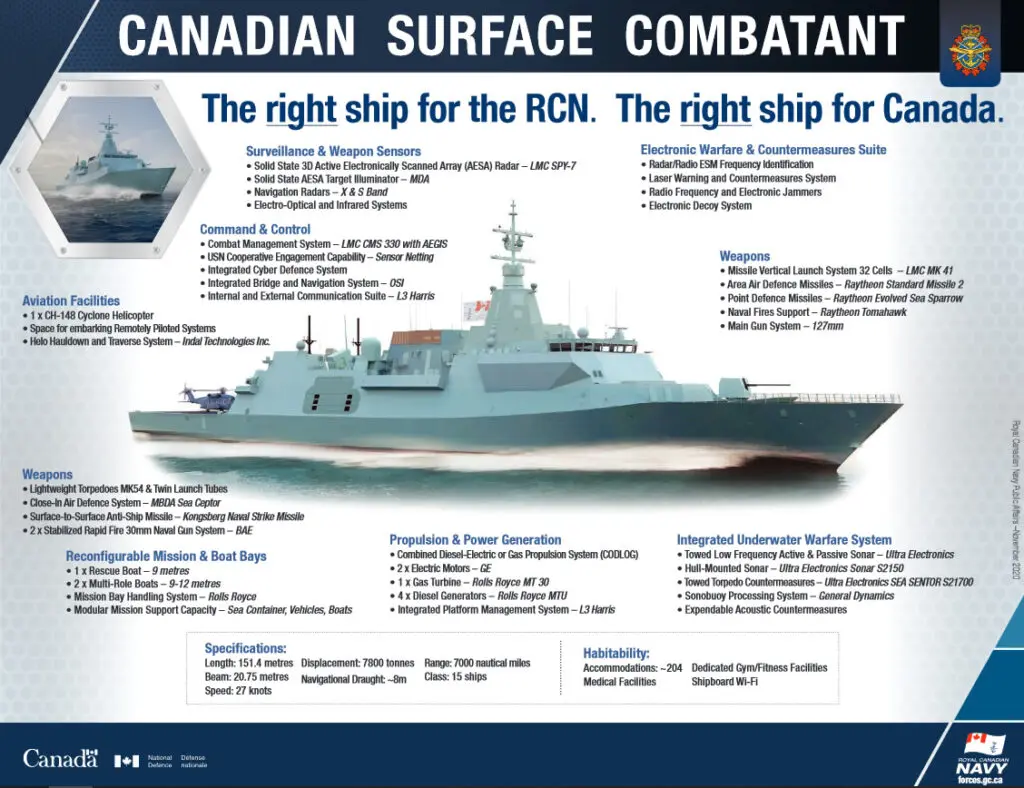
Surveillance & Weapon Sensors
Solid State 3D Active Electronically Scanned Array (AESA) Radar – LMC SPY-7
Solid State AESA Target Illuminator – MDA
Navigation Radars – X & S Band
Electro-Optical and Infrared Systems
Electronic Warfare & Countermeasures Suite
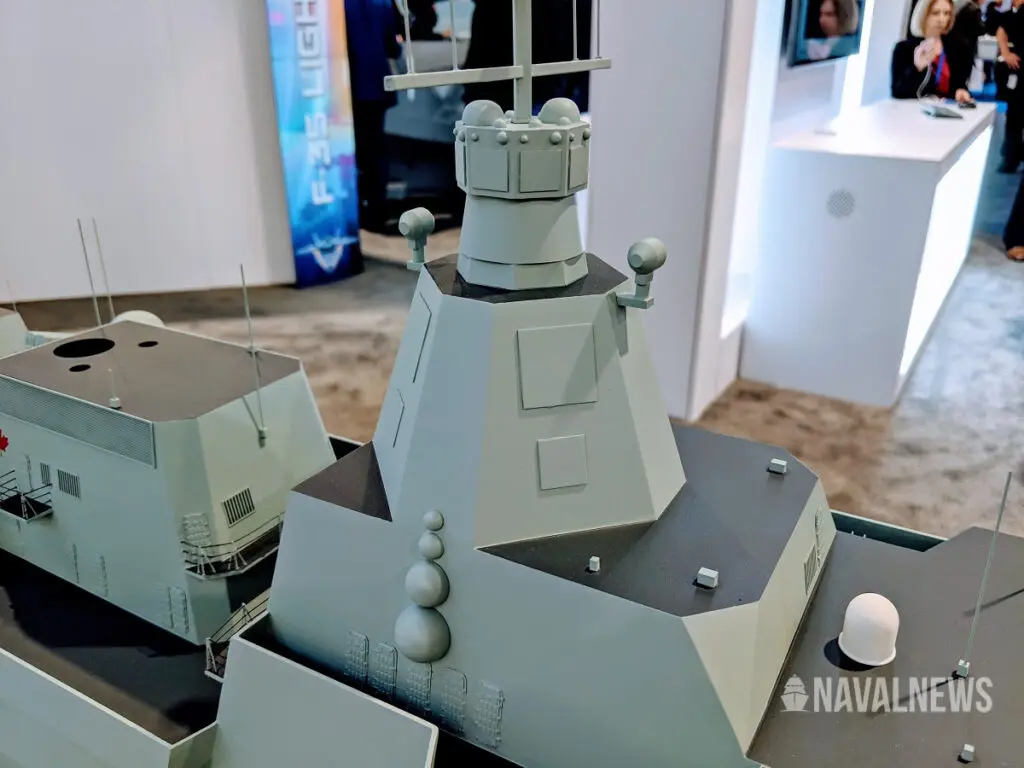
The semi-spherical arrays is part of the RAVEN electronic warfare system comprising communications electronic support measures (C-ESM), radar electronic support measures (C-ESM), and electronic attack (EA). Above them are the SPY-7 radar arrays and two EO/IR systems.
Radar/Radio ESM Frequency Identification
Laser Warning and Countermeasures System
Radio Frequency and Electronic Jammers
Electronic Decoy System
Naval News comments: An industry source informed us that except for the Torpedo decoy systems (to be provided by Ultra) the decoy launchers for CSC and their ammunition is one of the few systems that are still “up in the air”. We were told however that the RCN wants the full range of decoy types available on the market today: Infra red, chaff, corner reflectors, smoke for masking / screening and even offboard active decoys (such as Nulka). The EW suite of the CSC will be known as the RAVEN. Designed by Lockheed Martin Canada, it is based on the RAMSES system currently fitted aboard the Halifax-class frigates.
Command & Control
Combat Management System – LMC CMS 330 with AEGIS
USN Cooperative Engagement Capability – Sensor Netting
Integrated Cyber Defence System
Integrated Bridge and Navigation System – OSI
Internal and External Communication Suite – L3 Harris
Aviation Facilities
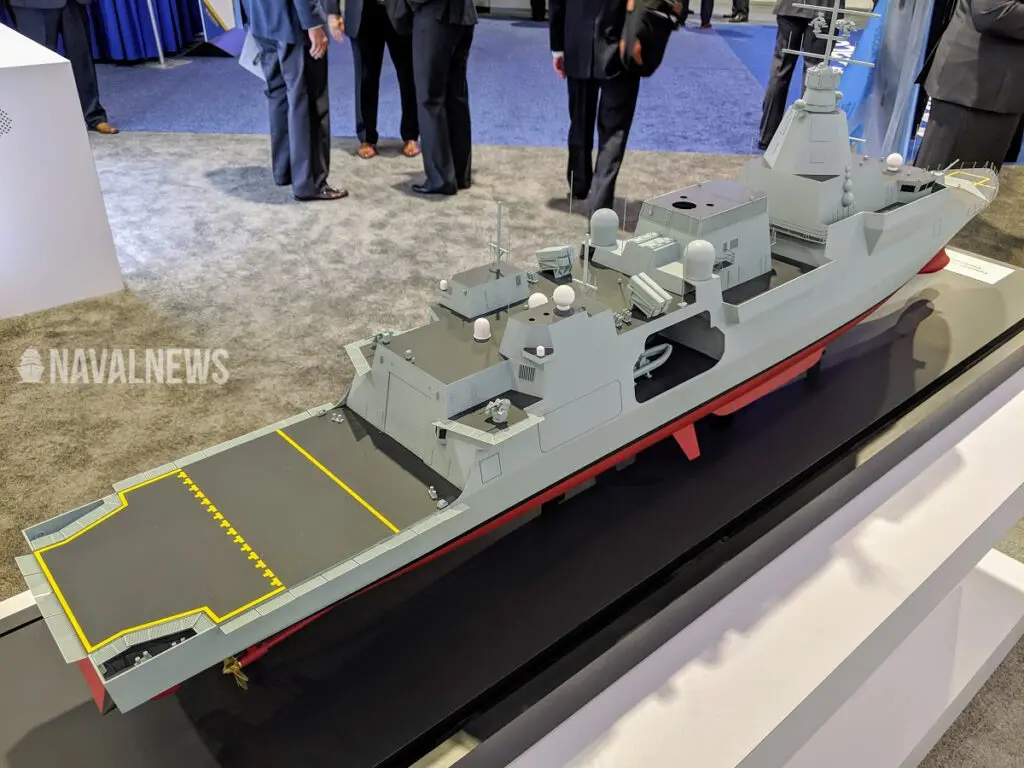
1 x CH-148 Cyclone Helicopter
Space for embarking Remotely Piloted Systems
Helo Hauldown and Traverse System – Indal Technologies Inc
Weapons
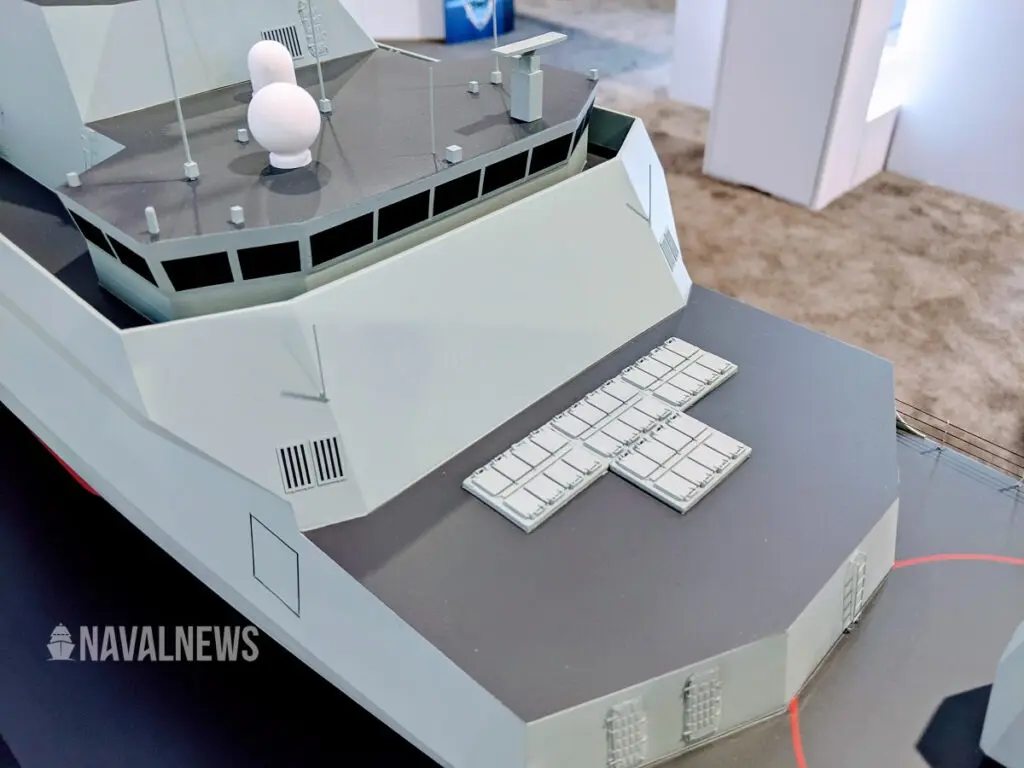
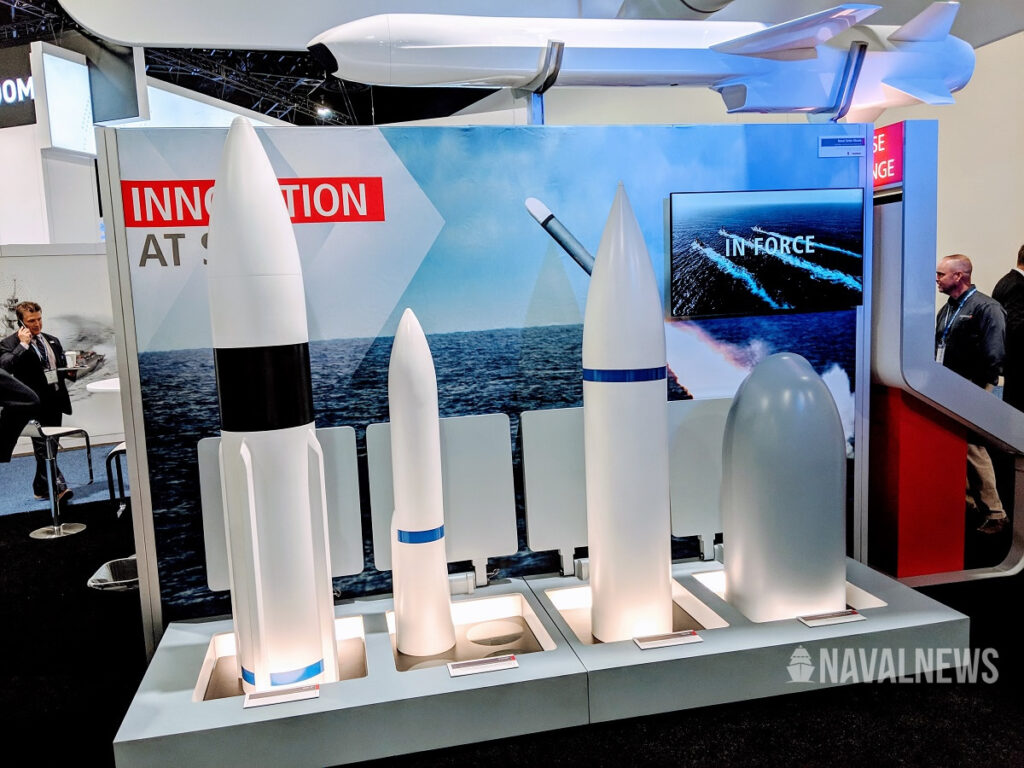
Missile Vertical Launch System 32 Cells – LMC MK 41
Area Air Defence Missiles – Raytheon Standard Missile 2
Point Defence Missiles – Raytheon Evolved Sea Sparrow
Naval Fires Support – Raytheon Tomahawk
Main Gun System – 127mm
Lightweight Torpedoes MK54 & Twin Launch Tubes
Close-In Air Defence System – MBDA Sea Ceptor
Surface-to-Surface Anti-Ship Missile – Kongsberg Naval Strike Missile
2 x Stabilized Rapid Fire 30mm Naval Gun System – BAE
Naval News comments: The main gun is another system on which the RCN has yet to formally make a choice. According to our sources, Italy’s Leonardo 127/64 LW is still in competition against BAE System’s Mk45 Mod 4. Note that the CSC scale models and illustrations (above) have always shown the American gun. In addition, the UK’s Type 26 and Australia’s Hunter-class frigates will both use the later naval gun system. A possible FMS of SM-2 Block IIIC missiles for the CSC was approved last week.
Reconfigurable Mission & Boat Bays
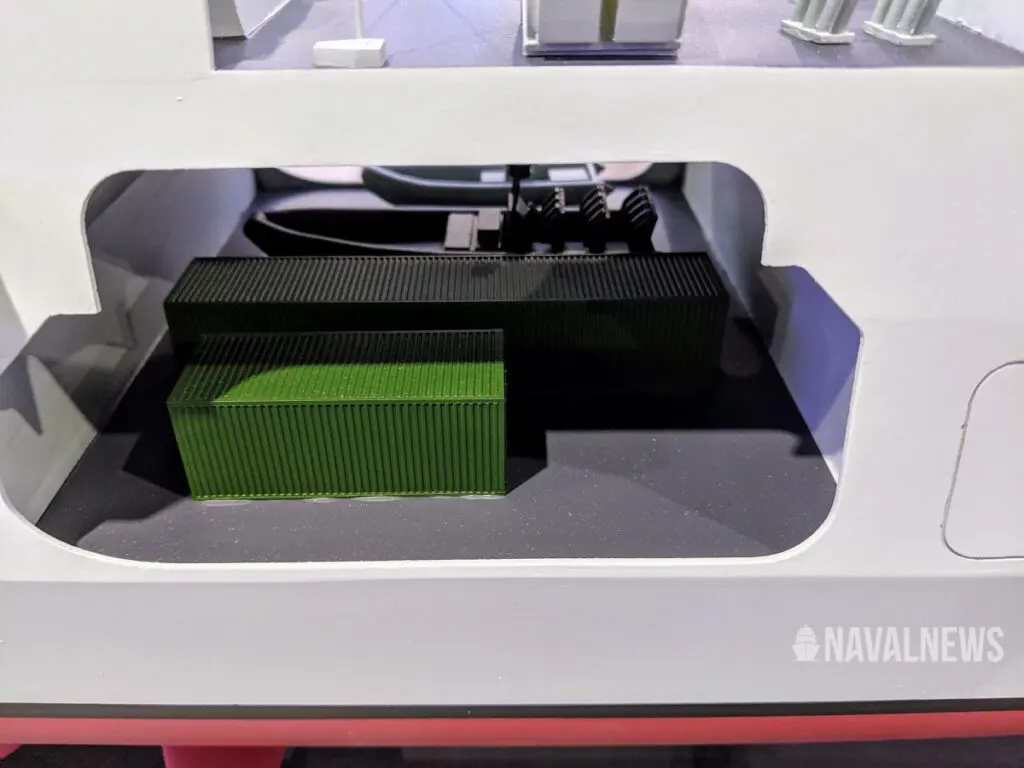
1 x Rescue Boat – 9 metres
2 x Multi-Role Boats – 9-12 metres
Mission Bay Handling System – Rolls Royce
Modular Mission Support Capacity – Sea Container, Vehicles, Boats
Propulsion & Power Generation
Combined Diesel-Electric or Gas Propulsion System (CODLOG)
2 x Electric Motors – GE
1 x Gas Turbine – Rolls Royce MT 30
4 x Diesel Generators – Rolls Royce MTU
Integrated Platform Management System – L3 Harris
Integrated Underwater Warfare System
Towed Low Frequency Active & Passive Sonar – Ultra Electronics
Hull-Mounted Sonar – Ultra Electronics Sonar S2150
Towed Torpedo Countermeasures – Ultra Electronics SEA SENTOR S21700
Sonobuoy Processing System – General Dynamics
Expendable Acoustic Countermeasures
Specifications:
Length: 151.4 metres
Beam: 20.75 metres
Speed: 27 knots
Displacement: 7,800 tonnes
Navigational Draught: ~8m
Range: 7000 nautical miles
Class: 15 ships
Accommodations: ~204
Naval News comments: The displacement figure (7,800 tonnes) shown on the RCN document is probably the “full load” displacement. For comparison, the official figure for the Royal Navy’s Type 26 frigate is 6,900 tons standard displacement while the official figure for the Royal Australian Navy’s Hunter-class frigate is 8,800 tons at full load.
In addition to the PDF unveiled last week, the Royal Canadian Navy Director of Naval Strategy, Captain Nucci, published an article on CSC in USNI’s proceedings:
Captain Christopher Nucci, Royal Canadian Navy, Proceedings, USNI, November 2020“Canada is pursuing a single class of 15 surface combatants for the Royal Canadian Navy (RCN), unlike some of its allies who are building multiple classes of more specialized ships. A single variant Canadian Surface Combatant (CSC) is better than the project’s original vision of two variants based on a common hull (the first a task group command/air-defense version, the other a more general-purpose/antisubmarine warfare version). While all naval force structure is essentially driven by national strategic defense and security interests, a single-class solution is based on three principal factors. First, it fits best for Canada’s unique naval requirements shaped by its geography, modest fleet size, and the RCN’s operational needs. Second, it optimizes effectiveness now and into the future, while responsibly seeking maximum cost efficiencies. Finally, it is an innovative approach that has only recently become both practical and advantageous because of recent technological developments, such as convergence and digitization.”
https://www.navalnews.com/naval-news/20 ... -frigates/




